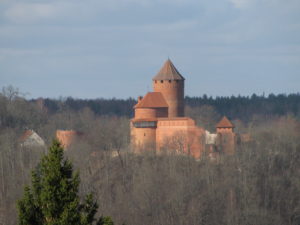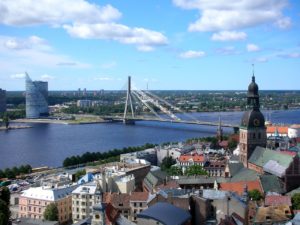Latvia is not a well-known country. In fact, when I was growing up, when I would tell people my grandmother was from Latvia, this was often the response I would get:
“Latvia? Where is that? Is that one of those small countries in Africa?
I would chuckle and then teach a short geography lesson. No, Latvia is not in Africa. It is nestled in between the vastness of Russia to the east and the Baltic Sea to the west. Across the sea is Scandinavia: Sweden, Finland, and Norway.

Latvia has a long history. It was settled by the Livonians in ancient times and the small tribes there actually traded amber to the Greeks and Romans! Latvia is still sometimes called “Amberland”. Since amber was extremely valuable in the Middle Ages, the lure of money brought many traders to the Latvian coasts and eventually, brought the first of many occupying armies to Latvia.

Traders from what is now known as Germany first came to Latvia in the mid-1100’s: less than a hundred years after William the Conqueror invaded England. From then until the late -1500’s, Germans dominated the land in a mostly feudal system with the Germans as the landlords and the Latvian people the peasants.
In 1521, the Reformation started by Martin Luther in Germany reached Germany and the Latvian people were finally allowed some freedom of religion. Interestingly, the Lutheran church is still the largest religion in Latvia.

Riga Dom Cathedral, built in 1211
A series of civil wars ended the sixteenth century, resulting in Latvia being divided into a free state of the city of Riga and several small vassal states paying tribute to Poland and Lithuania. Then Sweden took over for a while, about a hundred years lasting from the early 1600’s to the early 1700’s, until Peter the Great, ruler of the growing Russian Empire to Latvia’s east, began casting his eye toward the fertile land along the Baltic Sea with its highly valuable port cities. In 1710, Peter attacked and made Riga and the rest of Estonia (to the north) and Livonia (to the south) part of Russia. Since unfortunately this coincided with the advent of the Black Plague in the Baltic countries, over 75% of the population died in some areas.

Sigulda Castle – I have been up in that tower!
Russians nominally ruled Latvia from that time on, but the German nobility still mandated most daily affairs until 1812, when Napoleon attacked Russia and came through Latvia. Yes, you read that correctly. Napoleon was in Latvia! That amazed me when I first read it. I think of Napoleon in France, in Spain, and in Italy, but I never thought of his armies marching through Latvia. So on one side of my family tree, my ancestors were fighting England in the War of 1812, while the other side of my family tree was being attacked by Napoleon!

Latvian peasants in the 1800’s
After the Napoleonic Wars ended, Latvians started to develop a sense of national identity. After being occupied by so many countries for so many centuries, somehow the Latvian people had held on to their own culture. They still spoke their historic language, Latvian, which is one of the oldest living languages in existence. They still called themselves Latvian and had not assimilated into the German, Polish, Lithuanian, Swedish, or Russian cultures.
Over the next fifty years, nationalism spread across Latvia, and in 1905 the Latvian people revolted, attempting to throw off their Russian masters – as well as the German nobility who in many cases still treated the Latvians poorly.

Burned out German manor house after the 1905 uprising
Unfortunately, the revolt was unsuccessful, and the Russians and Germans together executed over two thousand Latvian nationalists. Ten years later, war would break out again as Germany declared war on Russia and attacked across Latvian lands in World War 1. Many battles were fought throughout the country and many Latvians – both soldiers and civilians- were killed.

German troops in Latvia in 1915.
When the war ended, the Latvians fought for their own freedom. Harsh battles against now-Soviet Russia eventually led to independence, and a free Latvia was formed. The new country then struggled for international recognition and a place in the League of Nations before finally being accepted by the world in 1922.
The next two decades were mostly peaceful and it was in this time that my grandmother was born, in 1923. The young country had its political difficulties and growing pains as they tried to figure out the best way to run a united Latvia, but they were making progress.
Unfortunately, we all know what happened next. World War 2 began, and once again Latvia’s larger, stronger neighbors waged war across her lands. June of 1940 began a decades-long occupation by Soviet Russia, only interrupted by a few years of Nazi control from 1941-1944. For the people of Latvia and the other Baltic states, the occupation that began with World War 2 did not end until 1991, when the Soviet Union collapsed.
I was lucky enough to visit Latvia twice. I have walked through Riga’s cobble-stoned medieval streets. I have seen destroyed buildings from WW2 finally being restored. I have spend hours in the Occupation Museum that documents the atrocities that were committed in Latvia in the twentieth century. I have seen the strength of the Latvian people as they forged a new country on democratic ideals.

Modern day view of the Daugava River flowing through Riga
Thankfully, now Latvia is a free country with over three decades of independence in its history. Hopefully their future will be bright as they continue to grow and form their national identity.
(All photos used are from Wikipedia and are in the public domain.)

Interesting! I suppose the history of Lithuania is similar. My grandfather was born there a little before 1920 and came to America with his parents as a child, eventually living and working construction projects in Cleveland.
SO very interesting!